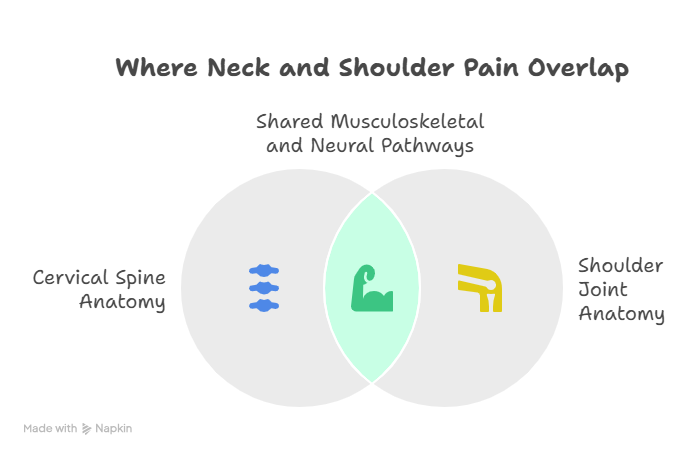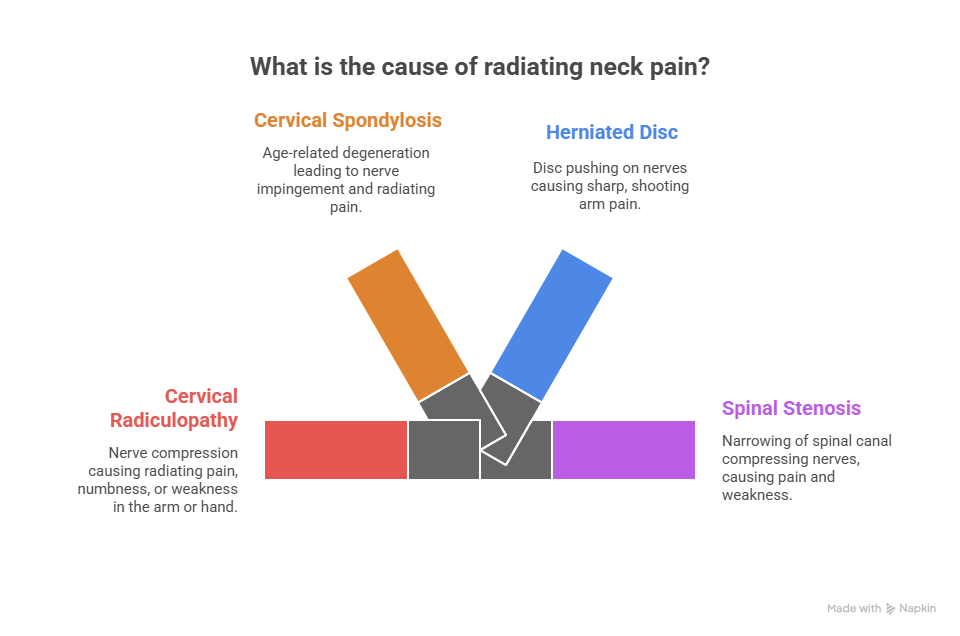I understand you’re looking for an in-depth and personalized exploration of pain in the left shoulder and left side of the neck. This kind of discomfort can be incredibly debilitating, affecting everything from simple daily tasks to your quality of sleep. I’m here to walk you through the complexities of this pain, offering a comprehensive look at potential causes, diagnostic approaches, and treatment options, especially when seeking care at the Best Shoulder Pain Hospital in India.
Let’s embark on this journey together, unraveling the mysteries behind your pain and guiding you towards understanding and potential relief. This isn’t just about symptoms; it’s about reclaiming your comfort and mobility.
Decoding Your Discomfort: Understanding Pain in the Left Shoulder and Left Side of the Neck
My friend, experiencing pain in your left shoulder and left side of your neck can be a truly perplexing and frustrating ordeal. It’s not just a localized ache; it can radiate, limit your movement, and even affect your mood and sleep. The connection between the shoulder and neck is intimate, with a complex network of muscles, nerves, and bones intertwining. This means that a problem in one area can often manifest as pain in the other.
This guide is designed to be your companion in understanding this intricate relationship and exploring the common, and sometimes less common, culprits behind your discomfort. Our goal is to empower you with knowledge, so you can have an informed discussion with medical professionals and ultimately find the relief you deserve, particularly when seeking the Best Shoulder Pain Hospital in India.
Don’t ignore pain in your left shoulder and neck — book an appointment with our expert doctor today for proper diagnosis and lasting relief.
Book an AppointmentThe Anatomy of Discomfort: Why Shoulder and Neck Pain Often Go Hand-in-Hand

To truly understand pain in the left shoulder and left side of the neck, it’s helpful to appreciate the anatomy involved.
- The Cervical Spine (Neck): This is the uppermost part of your spine, consisting of seven small vertebrae (C1-C7). It supports your head, allows for a wide range of motion, and houses the delicate spinal cord, from which nerves branch out to supply your arms, shoulders, and hands.
- The Shoulder Joint: This is a ball-and-socket joint, one of the most mobile in your body. It’s formed by three bones: the humerus (upper arm bone), the scapula (shoulder blade), and the clavicle (collarbone). Surrounding this joint is a complex arrangement of muscles (including the rotator cuff), tendons, ligaments, and bursae (fluid-filled sacs that cushion the joint).
- The Interconnection: Several muscle groups, such as the trapezius, levator scapulae, and sternocleidomastoid, originate in the neck and extend down into the shoulder and upper back. Nerves emerging from the cervical spine (the brachial plexus) travel directly through the neck and into the shoulder and arm. This intricate web explains why irritation or injury in one area can easily refer pain to the other.
Don’t ignore pain in your left shoulder and neck — book an appointment with our expert doctor today for proper diagnosis and lasting relief.
Book an AppointmentCommon Culprits: What Could Be Causing Your Pain?
Let’s explore some of the most frequent reasons someone might experience pain in the left shoulder and left side of the neck.
1. Musculoskeletal Issues (The Most Common):
- Muscle Strain/Spasm: This is often the simplest explanation. Overuse, poor posture (e.g., prolonged computer use, “tech neck”), stress, or sudden movements can lead to micro-tears or sustained contractions in the neck and shoulder muscles (like the trapezius, levator scapulae, or rhomboids). This pain is often dull, aching, and can be tender to the touch.
- Whiplash: A sudden, forceful back-and-forth movement of the head (common in car accidents) can strain ligaments, muscles, and even joints in the neck, with pain radiating to the shoulder.
- Rotator Cuff Injuries: The rotator cuff is a group of four muscles and their tendons that surround the shoulder joint, providing stability and allowing for arm rotation. Tears (partial or full) or tendinitis (inflammation) of these tendons are very common. Pain often worsens with arm movement, especially overhead activities, and can refer to the neck.
- Bursitis: Inflammation of the bursa (fluid-filled sacs) around the shoulder, often due to repetitive motion or impingement. This can cause sharp pain that radiates.
- Frozen Shoulder (Adhesive Capsulitis): A condition where the connective tissue surrounding the shoulder joint thickens and tightens, severely restricting movement and causing significant pain, often radiating to the neck. It typically progresses through painful, frozen, and thawing stages.
- Shoulder Impingement Syndrome: Occurs when the tendons of the rotator cuff or the bursa are “pinched” between the bones of the shoulder, especially during overhead arm movements. This can lead to pain that can sometimes refer to the neck.
- Osteoarthritis: Degenerative “wear and tear” arthritis can affect the facet joints of the neck or the shoulder joint itself, leading to stiffness, pain, and reduced range of motion.
- Rheumatoid Arthritis/Other Inflammatory Arthritis: Systemic autoimmune diseases that can affect joints throughout the body, including the neck and shoulder, causing inflammation, pain, and stiffness.
2. Cervical Spine Issues (Neck-Related Causes that Radiate):

- Cervical Radiculopathy (“Pinched Nerve”): This is a critical one to identify. When a nerve root in the cervical spine becomes compressed or irritated (often due to a herniated disc, bone spur, or spinal stenosis), it can cause radiating pain, numbness, tingling, or weakness in the shoulder, arm, hand, or fingers. The location of these symptoms depends on which nerve is affected.
- Cervical Spondylosis: Age-related degeneration of the discs and joints in the neck. This can lead to bone spurs and disc desiccation, potentially narrowing the spinal canal or foramina (openings where nerves exit), causing nerve impingement and radiating pain.
- Herniated Disc (Slipped Disc): The soft, jelly-like center of an intervertebral disc pushes through its outer layer, putting pressure on nearby nerves. This can cause sharp, shooting pain down the arm and into the shoulder.
- Spinal Stenosis: Narrowing of the spinal canal or the spaces where nerve roots exit, which can compress the spinal cord or nerves, leading to pain, numbness, and weakness.
Don’t ignore pain in your left shoulder and neck — book an appointment with our expert doctor today for proper diagnosis and lasting relief.
Book an Appointment3. Less Common, But Important Considerations:
- Referred Pain from Other Organs: It’s vital to rule out non-musculoskeletal causes, especially with left-sided pain.
- Cardiac Issues (Heart Attack/Angina): While often presenting as chest pain, a heart attack or angina (chest pain due to reduced blood flow to the heart) can sometimes radiate to the left arm, shoulder, neck, jaw, or back. If accompanied by shortness of breath, sweating, dizziness, or nausea, seek immediate medical attention.
- Gallbladder Issues: Pain from gallstones can sometimes refer to the right shoulder, but rarely the left.
- Diaphragmatic Irritation: Conditions affecting the diaphragm (e.g., pneumonia, subphrenic abscess) can sometimes cause referred pain to the shoulder, due to shared nerve pathways.
- Cardiac Issues (Heart Attack/Angina): While often presenting as chest pain, a heart attack or angina (chest pain due to reduced blood flow to the heart) can sometimes radiate to the left arm, shoulder, neck, jaw, or back. If accompanied by shortness of breath, sweating, dizziness, or nausea, seek immediate medical attention.
- Thoracic Outlet Syndrome (TOS): A group of disorders that occur when blood vessels or nerves in the space between your collarbone and your first rib (thoracic outlet) are compressed. This can cause pain in the neck, shoulder, and arm, along with numbness and tingling.
- Fibromyalgia: A chronic condition characterized by widespread musculoskeletal pain, fatigue, sleep disturbances, and tenderness in specific points, including the neck and shoulders.
- Tumors: Although rare, a tumor (e.g., Pancoast tumor in the lung apex) can sometimes cause shoulder and neck pain by pressing on nerves or invading surrounding structures.
- Infections: Rarely, infections in the bone (osteomyelitis) or disc (discitis) of the cervical spine can cause severe, localized pain that might spread.
When to Seek Medical Attention: Don’t Ignore the Signs
While some minor aches might resolve with rest, certain symptoms warrant prompt medical evaluation. You should definitely see a doctor, preferably at a facility like the Best Shoulder Pain Hospital in India, if you experience:

- Sudden, severe pain, especially after an injury or accident.
- Pain accompanied by numbness, tingling, or weakness in your arm, hand, or fingers.
- Inability to move your arm or shoulder.
- Deformity of the shoulder joint.
- Swelling, redness, or warmth around the shoulder or neck.
- Fever or chills accompanying the pain.
- Pain that worsens at night or wakes you from sleep.
- Unexplained weight loss.
- Pain that is accompanied by chest pain, shortness of breath, profuse sweating,
dizziness, or nausea (seek immediate emergency care). - Pain that does not improve with rest and over-the-counter pain relievers after a few days.
Don’t ignore pain in your left shoulder and neck — book an appointment with our expert doctor today for proper diagnosis and lasting relief.
Book an AppointmentThe Diagnostic Journey: Unraveling the Cause
When you visit a medical professional, particularly at a specialized center like the Best Shoulder Pain Hospital in India, they will embark on a systematic diagnostic process to pinpoint the cause of your pain in the left shoulder and left side of the neck.
- Thorough Medical History: This is the first and often most crucial step. The doctor will ask detailed questions about:
- The onset of your pain (sudden or gradual).
- The exact location and radiation of the pain.
- The type of pain (sharp, dull, aching, burning, shooting).
- Factors that worsen or alleviate the pain.
- Any associated symptoms (numbness, tingling, weakness, fever, weight loss, chest pain).
- Your occupation, hobbies, and daily activities.
- Any previous injuries or medical conditions.
- Your general health and medications.
- Comprehensive Physical Examination: The doctor will meticulously examine your neck and shoulder, which may include:
- Observation: Looking for any asymmetry, swelling, or muscle wasting.
- Palpation: Gently feeling for tenderness, muscle spasms, or abnormalities.
- Range of Motion Tests: Assessing your active and passive range of motion in your neck and shoulder.
- Strength Testing: Evaluating the strength of various muscle groups in your arm, hand, and shoulder.
- Neurological Examination: Checking your reflexes, sensation, and muscle strength to identify any nerve compression.
- Special Orthopedic Tests: Performing specific maneuvers to pinpoint issues like rotator cuff tears, impingement, or cervical radiculopathy.
- Diagnostic Imaging (If Needed):
- X-rays: Useful for visualizing bone structures, detecting fractures, arthritis, bone spurs, or alignment issues in the cervical spine or shoulder.
- MRI (Magnetic Resonance Imaging): Provides detailed images of soft tissues like muscles, tendons, ligaments, discs, and nerves. It’s excellent for identifying herniated discs, spinal cord compression, nerve root impingement, rotator cuff tears, and labral tears.
- CT Scan (Computed Tomography): Offers detailed cross-sectional images, particularly good for bony anatomy and sometimes used when MRI is contraindicated.
- Ultrasound: Often used for real-time visualization of tendons, muscles, and bursae in the shoulder, especially for rotator cuff assessment.
- X-rays: Useful for visualizing bone structures, detecting fractures, arthritis, bone spurs, or alignment issues in the cervical spine or shoulder.
- Electrodiagnostic Studies (If Nerve Involvement is Suspected):
- EMG (Electromyography) and NCS (Nerve Conduction Studies): These tests measure the electrical activity of muscles and the speed of nerve impulses. They can help confirm nerve compression, identify the specific nerve involved, and assess the severity of nerve damage.
Treatment Approaches: A Multi-Faceted Strategy
Once a diagnosis is made, your medical team will devise a personalized treatment plan. The approach to pain in the left shoulder and left side of the neck is often multi-faceted, ranging from conservative measures to, in some cases, surgical intervention. At a facility like Impact Ortho, you can expect a comprehensive strategy.
1. Conservative Management (Often the First Line of Treatment):
- Rest and Activity Modification: Temporarily avoiding activities that aggravate the pain is crucial. This doesn’t mean complete immobility, but rather intelligent modification.
- Medications:
- Over-the-Counter (OTC) Pain Relievers: NSAIDs (e.g., ibuprofen, naproxen) for inflammation and pain, or acetaminophen for pain relief.
- Prescription Medications: Muscle relaxants for muscle spasms, stronger NSAIDs, or neuropathic pain medications (e.g., gabapentin, pregabalin) for nerve-related pain.
- Over-the-Counter (OTC) Pain Relievers: NSAIDs (e.g., ibuprofen, naproxen) for inflammation and pain, or acetaminophen for pain relief.
- Physical Therapy: This is often the cornerstone of non-surgical treatment. A skilled physical therapist will design a program to:
- Reduce pain and inflammation.
- Improve range of motion in the neck and shoulder.
- Strengthen weakened muscles (e.g., rotator cuff, scapular stabilizers, neck extensors).
- Improve posture and body mechanics.
- Provide ergonomic advice for work and daily activities.
- Use modalities like heat, ice, ultrasound, or electrical stimulation.
- Injections:
- Corticosteroid Injections: Can be injected into the shoulder joint (for conditions like bursitis, tendinitis, or osteoarthritis) or around nerve roots in the neck (epidural or nerve root block for radiculopathy) to reduce inflammation and pain.
- Trigger Point Injections: For painful muscle knots.
- Corticosteroid Injections: Can be injected into the shoulder joint (for conditions like bursitis, tendinitis, or osteoarthritis) or around nerve roots in the neck (epidural or nerve root block for radiculopathy) to reduce inflammation and pain.
- Chiropractic Care/Osteopathic Manipulation: For certain musculoskeletal alignment issues in the neck and upper back.
- Massage Therapy: Can help release muscle tension and improve blood flow.
- Acupuncture: Some people find relief from pain through acupuncture.
Don’t ignore pain in your left shoulder and neck — book an appointment with our expert doctor today for proper diagnosis and lasting relief.
Book an Appointment2. Surgical Intervention (When Conservative Measures Fail):
Surgery is usually considered only after conservative treatments have been exhausted and if the pain is severe, persistent, or accompanied by progressive neurological deficits (e.g., significant weakness).
- For Shoulder Issues:
- Rotator Cuff Repair: To reattach torn tendons.
- Shoulder Arthroscopy: Minimally invasive surgery to address impingement, remove bone spurs, or repair labral tears.
- Shoulder Replacement: For severe osteoarthritis or other conditions where the joint is significantly damaged.
- Rotator Cuff Repair: To reattach torn tendons.
- For Cervical Spine Issues:
- Anterior Cervical Discectomy and Fusion (ACDF): To remove a herniated disc or bone spur and fuse the vertebrae to stabilize the spine.
- Cervical Laminectomy/Laminoplasty: To decompress the spinal cord or nerve roots by removing part of the vertebral bone.
- Cervical Disc Replacement: An alternative to fusion, preserving some motion in the neck.
- Anterior Cervical Discectomy and Fusion (ACDF): To remove a herniated disc or bone spur and fuse the vertebrae to stabilize the spine.
Living with and Managing Chronic Pain
If your pain becomes chronic, managing it effectively involves a holistic approach.
- Pacing Activities: Learning to balance activity and rest to avoid flare-ups.
- Stress Management: Stress can exacerbate pain. Techniques like mindfulness, meditation, yoga, or deep breathing can be helpful.
- Ergonomics: Optimizing your workspace and daily habits to support good posture.
- Regular, Gentle Exercise: Continuing a low-impact exercise program to maintain strength and flexibility.
- Support Groups: Connecting with others who experience similar pain can provide emotional support and practical tips.
- Psychological Support: A pain psychologist can provide strategies for coping with chronic pain, improving sleep, and reducing pain’s impact on your life.
Don’t ignore pain in your left shoulder and neck — book an appointment with our expert doctor today for proper diagnosis and lasting relief.
Book an AppointmentFAQs: Your Questions About Left Shoulder and Neck Pain Answered
Here are some frequently asked questions that might be on your mind when dealing with pain in your left shoulder and left side of your neck, especially when looking for the Best Shoulder Pain Hospital in India:
Is pain in the left shoulder and left side of the neck always serious?
Not always. Often, it’s due to muscle strain, poor posture, or minor overuse, which can resolve with rest, ice/heat, and over-the-counter pain relievers. However, it’s crucial to be aware of “red flags” like radiating numbness/weakness, severe sudden pain, or accompanying chest pain/shortness of breath, which warrant immediate medical attention.
Can stress cause left shoulder and neck pain?
Absolutely. Stress often leads to muscle tension, particularly in the neck and shoulders. Prolonged stress can cause muscles to tighten and spasm, leading to persistent aches and stiffness. Managing stress through relaxation techniques, exercise, and mindfulness can often help alleviate this type of pain.
What’s the difference between shoulder pain from the neck versus true shoulder joint pain?
Pain originating from the neck (cervical radiculopathy) often radiates down the arm, sometimes into the shoulder blade area, and can be accompanied by tingling, numbness, or weakness in the arm or hand. True shoulder joint pain is usually localized more directly to the shoulder area itself, often worsens with specific arm movements (especially overhead), and may involve a limited range of motion of the shoulder joint itself. A thorough examination by a specialist is needed to differentiate.
How long does it typically take for this kind of pain to resolve?
The duration varies widely depending on the underlying cause. Simple muscle strains might resolve in a few days to a couple of weeks. More complex issues like rotator cuff tendinitis or mild nerve impingement might take several weeks to a few months with consistent physical therapy. Chronic conditions or severe nerve compression might require longer-term management or even surgery. Patience and adherence to your treatment plan are key.
What kind of exercises can I do to help my neck and shoulder pain?
Gentle stretching and strengthening exercises are often beneficial, but it’s crucial to get a proper diagnosis first. A physical therapist can provide a personalized program. Common exercises might include neck stretches (gentle tilting, rotation), shoulder blade squeezes, pendulum exercises for the shoulder, and rotator cuff strengthening with light resistance bands. Always stop if you feel sharp pain.
When should I consider surgery for my shoulder and neck pain?
Dealing with pain in your left shoulder and left side of your neck can be challenging, but understanding its potential origins is the first step towards relief. Remember, seeking professional medical advice is paramount for an accurate diagnosis and effective treatment plan. The dedicated team at Impact Ortho stands ready to provide you with expert care, helping you regain your comfort and mobility. Impact Ortho is committed to being your partner on this healing journey.











